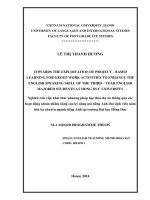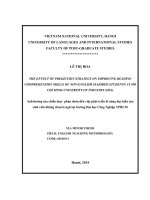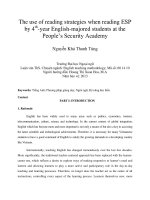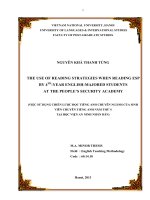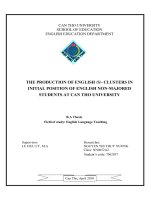The obstacles of english majored students at huflit when learning two languages at the same time graduation paper, major pedagogy english
Bạn đang xem bản rút gọn của tài liệu. Xem và tải ngay bản đầy đủ của tài liệu tại đây (544.35 KB, 46 trang )
HO CHI MINH CITY UNIVERSITY OF FOREIGN LANGUAGES –
INFORMATION TECHNOLOGY
GRADUATION PAPER
THE OBSTACLES OF ENGLISH-MAJORED
STUDENTS AT HUFLIT WHEN LEARNING
TWO LANGUAGES AT THE SAME TIME
Submitted by: Lam Khanh Hong
Student ID: 15DH710544
Major: Pedagogy English
Supervisor: Mr. Nguyen Thuong Tri, M.A
Ho Chi Minh City – 2019
1
2
Acknowledgement
I would like to thank the all volunteers from the Language Department in the survey who
have supported my work in this way and helped me get results of better quality. I am also
grateful to the participation of two lecturers with their valuable sharing.
Nevertheless, I am also grateful to the Mr. Nguyen Thuong Tri, M.A, my supervisor for
sharing his detailed instruction and his dissertation woes.
Last but not least, I would like to thank my family and my friends for supporting me
spiritually throughout writing this paper in particular and my life in general.
3
Abstract
To satisfy social requirements, Ho Chi Minh City University of Foreign Language –
Technology Information (HUFLIT) has obliged the students, especially undergraduates at
Foreign Languages Department to choose and learn another language besides their major
language. However, English-majored students at HUFLIT have found it difficult to
continue acquiring two languages at the same time. The aim of my research was to
determine the obstacles that English-majored students at HUFLIT had to overcome by
using the questionnaire powered by Google Form. Furthermore, there are two lecturers
sharing their judgment on students’ performance in class. The research findings have
shown not only many expected results related to phonics, the lack of students’
dependence on learning but also appropriate learning strategies.
Keywords: multilingual, bilingual, obstacles, phonics, acquiring
4
TABLE OF CONTENTS
CHAPTER 1: INTRODUCTION …………………………………………6
CHAPTER 2: LITERATURE REVIEW ………………………………….8
Definition of term …………………………………………………..8
Review on previous studies ………………………………………...9
Gap for present study ……………………………………………...14
CHAPTER 3: METHODOLOGY ………………………………………..16
Method approaches ………………………………………………..16
Participants and setting ………………………………………........16
Procedures ………………………………………………………...17
Data analysis ………………………………………………………17
CHAPTER 4: RESULTS ……………………………………………........19
Overview ……………………………………………………….....19
Data collected through questionnaire ……………………………..20
Data collected through interviews ………………………………...31
CHAPTER 5: DISCUSSTION ………………………………………...…32
The original hypothesis and objective …………………………….32
Findings, reflections and explanations ……………………………32
Limitations ………………………………………………………...32
Recommendations…………………………………………………32
CHAPTER 6: CONCLUSION …………………………………………...33
REFERENCES …………………………………………………………...34
5
CHAPTER 1: INTRODUCTION
As an observer, I have found that language is becoming an essential factor
which facilitates our careers and job promotions. To illustrate, the salary
level of people who are able to communicate fluently in at least two
languages is obviously higher than that of the ones who just speak one
language. In today's world, Vietnam is moving towards global integration
and expanding global markets as well as economic relations. English is
regarded as the international language which is used all over the world.
Somehow, many head hunters and employers in Vietnam prefer recruiting
people who not only specialize in their fields but are also able to speak
English fluently.
Furthermore, according to Satander Trade Hub's appraisal in 2019, Vietnam
is "one of the most attractive countries in terms of FDI in Asia" and have
drawn foreign investment mostly from Japan, South Korea and Singapore.
Therefore, there are many foreign corporations from those countries which
have placed their branches in Vietnam. This situation not only
accommodates the Vietnamese with career opportunities but also issues
many challenges. As a result, the Vietnamese employees have to compete
against their compatriots and other foreigners in order to achieve superior
positions. Thus, the ability to communicate in those languages such as
Japanese, Korean and Chinese as well becomes the huge advantage to be
outstanding.
HUFLIT – a private university in Ho Chi Minh City, Vietnam - determines
its mission as the satisfaction of social requirements about well-trained
human resources. HUFLIT are trying to exploit the potentialities of their
students by requiring them, exceptionally undergraduates in the Foreign
Languages Department to acquire an optional language while studying their
majored one - English. Unfortunately, there is a large number of students
finds it difficult to learn two languages at the same time. They have got bad
results or even failed in the optional language subject. Some of the students
are being at a standstill to solve their major language and the optional one
as well.
It is clear that the language-acquiring process is tough and complicated;
therefore, many Foreign Languages (FL) learners experienced how difficult
it is. There are many researchers having conducted several surveys
6
surrounding multilingual ability such as its beneficial impacts on
intellectual improvement by Kluger in the article "How the Brain Benefits
From Being Bilingual" (2013) and Vince in “The Amazing Benefits of
Being Bilingual” which was published in BBC newspaper (2016). Gandara
& Acevedo’s findings (2016) proved that the importance of bilingualism
has a substantial impact on economic expansion. However, there is a
shortage of studies clarifying the obstacles of two-language-acquirement,
especially which students have to overcome. As a senior in the Department
of foreign languages, it is necessary for me to conduct a survey to examine
the attitude of English-majored students towards the optional language
subject in HUFLIT.
The purpose of this paper is to investigate the difficulties of HUFLIT
students when learning two languages at once. This topic is supposed to be
a premise to figure out the solutions to this struggle, not only for students to
pass this subject; but also for the Department to improve the teaching
quality in HUFLIT.
7
CHAPTER 2: LITERATURE REVIEW
Definition of terms
Bilingual
According to Baker (2001), bilingualism is identified as the capability of
using more than one language. Besides, Bloomfield (1933) claimed that
bilingualism is the ability to be fluent in two languages like the native
whereas Haugen (1953) and Weinreich (1953) reckoned a person who is
able to speak two languages even inarticulately can be considered a
bilingual. As a result, it is difficult to categorize individual who is and who
is not bilingual. In 2006, Baker continued to define the term "bilingual"
"...Bilinguals use their two languages with different
people, in different contexts for different purposes.
Levels of proficiency in a language may depend on
which contexts (e.g. street and home) and how often
that language is used." (Baker, 2006)
Many researchers also shared the view with Baker (2006), especially Garcia
(2011) when he described bilingualism as "not one plus one" progress.
Similarly, Myers-Scotton named this type of bilinguals "dominant
bilingual". So far, we can accept that English-majored students at HUFLIT
as bilinguals.
Bilingualism education
Bilingualism acquisition has been also a noticeable topic which drew a lot
of attention from many researchers for a long time. Houwer (1996)
demonstrated the term "simultaneous bilingualism” which happened when
both languages are learnt the same time. On the contrary, the progress of
one language acquisition then another is defined as "sequential
bilingualism" (Flynn et al., 2005). In Vietnam, freshman students generally
have learnt English for a long time since English is the compulsory subject
of secondary and high school's syllabus. Besides, English-majored students
are required to acquire English and optional language simultaneously. As a
result, both kinds of bilingualism will be considered in this research paper.
8
Review on previous studies
1. The challenges of simultaneous and sequential bilingual acquisition
A 2016 article (Elbes) stated that multilingualism has been totally a desire
of most experts to approach the knowledge source in a foreign language,
especially in science and medicine fields since hundreds of years ago. This
thirst can be effortlessly understandable in virtue of the benefits provided
by bilingualism in particular.
In order to achieve this goal, all learners are required to spend much time
and serious effort. There are several hurdles that learners have to overcome
in order to use a new language fluently. Many linguistic experts have
identified those issues in many aspects of language:
•
Pronunciation
•
Lexis
•
Grammar
•
Alphabet
Pronunciation
First, pronunciation is reputed to be "an indispensable component of
second-or-foreign-language" and it can be a prerequisite that a native can
understand the nonnative's expression (Leather, 1983). Each language has
its own pronunciation system.
In 1980, Culter pointed out that the most common pronunciation error was
"Lexical Stress Errors". In his article, Culter gave the number of evidence
provided by Fromkin's paper in 1973 and 1976. Furthermore, he also
conducted many corpora of this error and showed some possible hypotheses
explaining this phenomenon. Ababneh (2018) conducted research on
English pronunciation errors made by Arabic students who speak English
as a foreign language. Unsurprisingly, stress problem was one of the
remarkable pronunciation mistakes when most of the students who both
majored and non-majored in English "missed the stress on the right
syllabus" in some selected words (Ababneh, 2018). Furthermore, a study
9
was done Caramazza et al. (1973) to examine bilingual French-English
speakers' pronunciation. They were required to pronounce six common
stop-vowel syllables. The findings indicate the poor control of phonetic
perception.
Besides, Ellis and Beaton (1993) provided examples of the varied
"articulatory features" by comparing five Chinese words which have the
same pronunciation but different tone then lead to distinctive meaning. It
can be related to Vietnamese accent that many foreigners have found it
difficult to learn and remember. Inversely, Vietnamese are found to add
diacritics when speaking foreign language as a habit.
Vocabulary
According to Meara (1980), most foreign language learners consider
vocabulary the most challenging obstacle when learning a language; thus,
they have just acquired the basic lexis after a long time. Most of Foreign
Language learners have once experienced forgetting vocabularies which
have just been learned. Groot & Keijzer (2000) from the University of
Amsterdam demonstrated that learners are confused by complete
discrepancies among the meanings of a word as well as the variety of wordtypes in different languages.
However, in 1913, Ronjat published a book instructing how to raise a kid
bilingual, which took his son as a model of the bilingual acquisition of
French and German. Fortunately, Louis, Ronjat's son, performed the
remarkable ability in both languages. Besides, a study was conducted by
Kaushankaya et al. (2009) to investigate how bilingualism influences the
acquisition of vocabulary in novels compared to monolingualism. It is
found that bilingualism facilitates word-learning progress when bilingual
volunteers performed better than people who speak only one language.
Besides, there are many studies which put the advantages of bilingualism
into doubt. According to Leopold (1949), her daughter who was exposed in
English and German simultaneously showed the confusion of utilising
appropriate vocabulary between those languages. Otheguy et al (2010)
continued to strengthen this phenomenon by stating that Spanish-English
speakers usually use the Spanish word "edificio" for the buildings or school
Similarly, Arsenian (1945); Darcy (1953) and Macnamara (1966)
pinpointed symptom of lexical decline on bilingual children.
10
Grammar
Grammar could be one of the issues that FL learners are concerned about
due to its complexion. According to The TELF Academy's blog on August
2017, students have to struggle with sentence structures in various
languages which are constructed in assured order. For instance, on
Vnexpress newspaper, Pham (2016) pointed out one of the challenges
Vietnamese may face when learning Japanese that the vast difference in
Japanese grammar; while Vietnamese and English are SVO language (
Subject - Verb - Object), Japanese is set up by SOV order. Similarly,
Dopke (2000) regconizes that English-German students apply -VO word
order in all German sentences whereas German uses both -VO and -OB
word order. Volterna et al (1978) concluded that bilingual adolescents tend
to apply "the same syntactic rules to both languages". Meisel (1989) is in
agreement that bilinguals find it difficult to distinguish two grammatical
structures, which is highlighted and defined as "fusion" by Wolck (1994).
Alphabet
As we all know, there is an interaction between speaking and writing
language (Garton et al, 1998), especially the fluency of reading and writing
helps to improve linguistic development (Hatano,1995). Therefore, literacy,
or alphabet in especially, plays a vital role in language acquisition.
However, people who learn Chinese, Korean, and so on which use
hieroglyphic characters can find it difficult to acquire the alphabets.
Chinese alphabet contains over 80,000 characters, and learners are required
to comprehend at least 3500 standard Chinese (Wagner,2011). Pham (2016)
also continued that Japanese has 3 alphabets such as "Hiragana",
"Katakana" and "Kanji"; moreover, each one is used for various reasons
and Japanese can use three alphabets in one context. The alphabets
mentioned are pictographs, which can take sequential bilinguals a period of
time to adapt and acquire, especially students who get used to the Roman
alphabet. The results from Oriyama's study (2001) also showed that there
was a delay of Japanese literacy in Japanese-English students in Australia.
Besides, an investigation was conducted by Raynolds (2010) to compare
the English spelling of Spanish-English children with native English ones.
Bilingual kindergarteners were found to have made more mistakes than the
11
monolingual group on ending stop consonants, which were phonetically
different in English and Spanish.
2. The influence of motivation in sequential bilingual acquisition
The classification of motivation in language acquisition
Gardner and Lambert (1972) found out the role of motivation in the
progress of second language acquisition [SLA]. They also defined it as two
categories:
-
-
Integrative motivation - In this type, learners acquire a
language because of their interest in the country of the
language they are learning.
Instrumental motivation - In this type, learners consider the
target language necessary for their career or study.
Dörnyei (1994) also claimed that "L2 motivation is an eclectic, multifaced
construct"; so that he elaborated the model of motivation in SLA as three
aspects of language:
-
-
-
The social dimension - "the exact nature of the social and pragmatic
dimensions of L2 motivation is always dependent on who learns
what languages where."
The personal dimension - in which, the SLA motivation is
contributed by self-determination, self-efficacy, self-confidence, and
need for achievement, etc.
The educational subject matter dimension - which includes:
" 1) course-specific motivational components
concerning the syllabus, the teaching materials, the
teaching method, and the learning tasks; 2) teacherspecific motivational components concerning the
teacher's personality; teaching style, feedback, and
relationship which the students and 3) group-specific
motivational components concerning the dynamics of
the learning group." ( Dörnyei, 1994, 277)
12
The importance of motivation in language acquisition
Many researchers indicated that motivation has a great influence on the
second language acquisition. According to Gardner (1985), "the extent to
which the individual works or strives to learn the language because of a
desire to do so and the satisfaction experienced in this activity". In other
word, attitude influences motivation of language acquisition. He also
claimed that motivation is regarded as a cause of the success of language
acquisition (Gardner, 1985). Khasinah (2014) continued that this factor is
able to contribute to the process of acquiring a language either positively or
negatively.
In my opinion, the statements mentioned by Gardner (1985) and Khasinah
(2014) are valuable, which can be concerned as one of the causes of the
obstacles when learning two language of English-majored undergraduates.
3. The influence of language learning strategies
The classification of language learning strategies
In 1990, O'Malley and Chamot introduced language learning strategies as
three categories for the very first time as they stated "there was no theory to
guide our studies and few empirical investigations into the nature of
learning strategies and their influence on second language acquisition"
-
-
Metacognitive strategies, which referred three stages of learning
process such as planning (pre-task), performing (while-task) and
evaluating (post-task).
- Cognitive strategies, which "addresses specific language
comprehension and language production processes"
- Social strategies, which learners could take advantage of
surrounding environment to facilitate the learning acquisition.
Furthermore, in this year, Oxford also classified this term as six types such
as:
- Cognitive.
- Mnemonic, which emphasized the using of formulas, phrases and
examples in learning.
- Metacognitive.
- Compensatory, which could be used for developing reading and
writing skill.
13
-
Affective, which mentioned the learners' attitude and motivation.
Social, which involved the relationship of language acquisition and
background knowledge. (1990)
However, there are some drawbacks of these classifications. According to
Chamot et al. (1990), learners misunderstood learning tasks as difficulties;
so that they tended to use "problem-solving strategies" instead of "learning
strategies" .
Similarly, Chamot (2014) claimed that
"...in the discussions surrounding the various ways of
naming, describing, and classifying language learning
strategies, little attention has been paid to students'
learning goals or teachers' instructional goals."
(Chamot, 2014)
2. The importance of language learning strategies
Cohen et al. (2007) defined language learning strategies as the process
performed by language learners in order to study and practice language
efficiently. Besides, Joan (1975) clarified language learning strategies with
several features such as "the learning stage", "the age of the learners",
"individual styles", etc. after the detailed observation of good language
learners.
Appropriate learning strategies play a crucial role on successful language
acquisition. According to Thomas and Rohwer Jr. (2011), "the phenomena
of studying in academic domains are characterized and analyzed with
special reference to the role of learning strategies". Especially, Breen
(2014) added that "learning strategies are important in second language
acquisition for two major reasons", which helps both learners who can
"understand these mental processes as they relate to second language
acquisition" and teachers who can "teach less successful language learners".
Gap for the present study
As I mentioned previously, there are few researches on the obstacles of
learning two languages as the second and third language simultaneously.
Universities in Vietnam are striving to improve students' ability in order to
meet the employers' requirement. Many of the previous studies showed the
14
challenges of both simultaneous and sequential bilingual acquisition.
However, I find those findings still inconclusive though they have used as a
firm foundation for my study.
In conclusion, I hope that I am able to find out the obstacles of learning two
languages at the same time that English-majored students are struggling in
the Vietnamese context, at HUFLIT in particular.
15
CHAPTER 3: METHODOLOGY
Method approaches
As a teacher-to-be, I felt an urge to seek out those challenges which my
friends in particular, and English-majored undergraduates, in general, have
met when acquiring two languages at the same time. Hence, I could gain
more experiences in teaching and learning strategies in order to help my
less successful students in the future. I have just had a limited amount of
time due to the present condition as a senior. Furthermore, I also
acknowledged that conducting a survey which aims to figure out the cause
of a phenomenon with "precise measurements" and "controlled
environment", there was nothing more appropriate than quantitative
approach (Greg, 2007), especially descriptive one, which "helps the
researcher evaluate the statistical output in the proper context" (Creswell,
2003). Therefore, the methods mentioned below would be used:
(1) Questionnaire: (Appendix A) I examine students' attitude toward the
obstacles they have found when learning another language at the same time.
(2) Interview: (Appendix B) I have interviewed two lecturers who are
teaching French and Japanese for English-majored students in order to
approach teachers’ attitude toward the obstacles of bilingual acquisition.
Participants and settings
This research paper is set in the context of Vietnam, particularly in the Ho
Chi Minh City University of Foreign Language - Technology Information
(HUFLIT). All the participants major in English. Consequently, they have
experienced at least once the "optional language" subjects ranging from
Japanese to Chinese, which results from the requirement of the Foreign
Language Faculty in the recent years. In spite of being the same
Department, these undergraduates have diverse backgrounds when they've
enrolled in various fields of English including Pedagogy, Business,
Translation and Interpretation. Moreover, they are studying in different
school years. As the result, their view points toward this topic can be
considered objectively and reliably.
There were two lecturers coming from Faculty of Oriental Studies
participated in short interviews which aims to identify English-majored
16
undergraduates' struggles and weaknesses when studying the optional
language subject under teacher's observations. Two interviews were also
executed separately.
Procedures
On the 6th week of the research process, I have sent the link of
questionnaire powered by Google Form to several private groups of
HUFLIT students, especially English-majored undergraduates. Fortunately,
this questionnaire was responded positively by 46 English-majored
participants after 2 weeks.
After collecting the coded-data, I decided that my research needed feedback
which is responded by lecturers who are teaching the optional language
subjects. Thanks to the assistance of my friends, I have received contacts of
two lecturers who are teaching French and Japanese. Then, I have set up
two informal interviews on the 8th and 9th week of the process. Two
lecturers were so willing to express their attitudes toward English-majored
students’ performances in their class as well as their personal experience of
bilingual acquisition simultaneously when they were students.
Data analysis
The questionnaire called "The obstacles of English-majored students when
studying the optional language at HUFLIT" was used in the survey. Its
content was based on the findings of the previous researches which were
mentioned in Chapter 2.
There were 13 questions on the questionnaire. The three first questions
were designed to narrow the amount of subjects that this study targets,
seven next questions were about their attitudes towards the optional
language subject; specifically their obstacles and learning styles. Finally,
three last questions investigated their points of view and expectation for the
possible solutions. The questionnaire was arranged on multiple choices.
Subjects could respond by clicking on the most suitable answers. Before
conducting the survey, a copy of the questionnaire was handed into the
lecturer and got approval from him. This questionnaire was done
completely to see:
17
-
The difficulties student could get when learning two languages at the same
time.
The reason why they had chosen their own optional language.
The specific study plans to solve this barrier.
Their expectations from the Department to figure out this issue.
Their possible solutions for the optional language subject.
Their points of view about the importance of this subject.
The questionnaire was successfully answered and returned by a total of 50
undergraduates from HUFLIT. All these students who had taken part in this
survey are studying in Foreign Languages Department. Thanks to Google
Forms' technology (powered by Google), the data collected from the
questionnaires was analyzed and illustrated into 12 charts.
Another data analysis resulted from the interview with two college lecturers
who have taught Japanese and Chinese for English-majored students. They
were asked to share their observations on undergraduates' abilities and
behaviors in the classroom. Furthermore, the lecturers also shared their
experiences of language acquisition. Two interviews were recorded and
scripted. Their transcripts will be shown fully in the later part of this paper.
18
CHAPTER 4: RESULTS
Overview
This chapter aims at the investigation into the difficulties of being trilingual
by the analysis of research findings. The result of questionaire which
conducted the survey was analyzed to identify and clarify the issues of
learning two languages at the same time. The research questions were
completed by 46 HUFLIT English-majored students and two lecturers who
are being responsible for the optional language subjects. The outcome was
presented under 12 charts below for better understanding.
19
20
Three charts above indicate background information of participants of this
survey. There are 26 seniors, 4 juniors, 13 sophomores, and 3 freshmen.
Nearly 70% of subjects are taking part in at least 1 option language course
at the present. It also can be seen half of the subjects decided Japanese as
their optional language. Meanwhile, 11 undergraduates chose Chinese to
learn, accounting for 21,7% followed by which 15,2% of English-majored
students studied French. Only 13% of students claimed learning Korean,
which has just been taught since 2016 because of the limited number of
lecturers. Those diverse backgrounds promise the overall viewpoints
towards the topic of this paper.
21
The pie chart illustrates the times which English-majored undergraduates
have participated in the optional language course recently. It can be seen
that most participants had to retake this subject many times. Approximately
two-fifths of participants admitted learning the optional language course
more than 3 times, while 23,7% and 10,5% students also took part in those
classes twice and three times. Only 26,3% were undergraduates who have
just experienced once.
So far, it is clear that English-majored
undergraduates were struggling with the optional language.
22
The pie chart above reveals why English-majored undergraduates chose the
language that they are acquiring at the moment. Half of the number of
participants of this survey gave out their decision for the optional language
which was dictated by feelings. 23,9% of students consulted with their
friends and family before deciding their optional language. It is a good sign
that 17,4% of subjects had considered social demand. However, just only
8,7% of students chose the optional language as the guideline from the
department. The result urges the possibility of adequate and specific
instruction for the English-majored freshmen when they choose the
language which is suitable for their ability besides English.
23
The bar graph above indicates the acquisition phase of English-majored
students for the optional language which excluded the time in the
classroom. Only 5 participants among 46 volunteers, accounting for
approximately 11%, claimed that they had spent more than 5 hours per
week learning that subject. The proportion of students who sometimes
learned the optional language outside the classroom made up 32,6%.
Besides, there are still a large number of English-majored students stated
that they hardly ever, or even worse, never taking a look at the course
books of the optional language subjects.
24
The chart above indicates the approaches by which English-majored
students acquire and practice the optional language. Nearly 70% of
undergraduates studied on their own, which is recommended for higher
education due to several benefits. However, according to Benson (2007),
"learners do not develop the ability to self-direct their learning simply by
being placed in situation where they have no other option" (p.22). More
than a fifth of participants registered a course in the language centers,
meanwhile 8.7% of subjects learned in group with their friends. Nobody
was able to afford one-on-one classes with a private tutor. It can be seen
that there was a shortage of community approaches such as language clubs
which can connect learners by communication activities.
25


